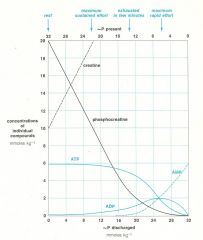![]()
![]()
![]()
Use LEFT and RIGHT arrow keys to navigate between flashcards;
Use UP and DOWN arrow keys to flip the card;
H to show hint;
A reads text to speech;
13 Cards in this Set
- Front
- Back
|
Describe the alternative high energy phosphate compound that serves to maintain the ATP pool.
|
PHOSPHOCREATINE
|
|
|
Compare the rate of ATP synthesis between Creatine Kinase and Oxidative Phosphorylation.
|
ATP synthesis via Creatine Kinase is 10 times faster than from oxidative phosphorylation
|
|
|
Describe the function of the Phosphocreatine Shuttle.
|
Phosphocreatine Shuttle is designed to maintain the [ATP] relatively constant until the muscle nears exhaustion.ATP from mitochondria is transported to cytososol so it can be used by muscle, phosphocreatine is exchanged into mitochondria to regenerate ADP to ATP
|
|
|
Describe the Phosphocreatine / ATP energy pool timeline during exercise.
|
Phosphocreatine levels are rapidly depleated as they donate their phospate to sustain the ATP stores. When they are depleated the ATP stores drop and the muscle reaches exhaustion.
|
|
|
Indicate the difference between Creatine and Creatinine.
|
Creatinine is a breakdown product of Creatine (among other things). It has lost a H2O and is rid of by the kidneys.
|
|
|
Identify the dietary and endogenous sources of Creatine.
|
Dietary = beef, fish, suppliments
Endogenous = liver |
|
|
List the pros and cons of Creatine Supplementation
|
Pros: Strength, Muscle Mass, Speed
Cons: Cramps, Diarrhea, Bloating, Injuries, unknown effects of creatinine |
|
|
What is the function of the Phosphocreatine Shuttle?
|
Phosphocreatine Shuttle is designed to maintain the [ATP] relatively constant until the muscle nears exhaustion.
|
|
|
Describe the Phosphocreatine / ATP Energy Pool timeline?
|

--
|
|
|
Identify the 2 main energy sources of the heart.
|
Glucose & Fatty Acids (heart prefers)
|
|
|
Identify the metabolic pathway stimulated during a myocardial infarct.
|
Glycolysis
|
|
|
Describe the benefits of glycolysis on a hypoxic or ischemic heart.
|
Glycolysis supports an hypoxic or ischemic heart. It delays progression of the ischemic contraction & increases chances that functionality will be restored upon reperfusion.
|
|
|
Use Evidence Based Medicine to evaluate GIK therapy for MI patients.
|
The initial trials suggested that GIK infusion might be beneficial in patients with acute coronary syndromes who were not treated with reperfusion. However, the more recent trials (GIPS-I, GIPS-II, and CREATE-ECLA) utilizing current rapid reperfusion therapies have failed to demonstrate any benefit in the administration of GIK with acute coronary syndromes.
|

